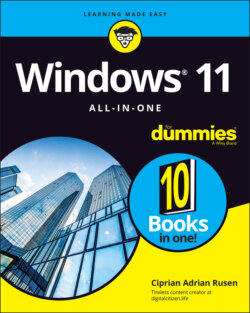Читать книгу Windows 11 All-in-One For Dummies - Ciprian Adrian Rusen - Страница 22
Displays
ОглавлениеThe computer monitor or screen — and LED, LCD, OLED, and plasma TVs — use technology that’s quite different from old-fashioned television circuitry from your parent’s childhood. A traditional TV scans lines across the screen from left to right, with hundreds of lines stacked on top of each other. Colors on each individual line vary. The almost infinitely variable color on an old-fashioned TV combined with a comparatively small number of lines makes for pleasant but fuzzy pictures.
By contrast (pun intended, of course), computer monitors, touch-sensitive tablet screens, and plasma, LED, OLED, and LCD TVs work with dots of light called pixels. Each pixel can have a different color, created by tiny, colored gizmos sitting next to each other. As a result, the picture displayed on computer monitors (and plasma and LCD TVs) is much sharper than on conventional TV tubes.
The more pixels you can cram on a screen — that is, the higher the screen resolution — the more information you can pack on the screen. That’s important if you tend to have more than one word-processing document open at a time, for example. At a resolution of 1024 x 768, two open Word documents placed side by side look big and fuzzy, like caterpillars viewed through a dirty magnifying glass. At 1280 x 1024, those same two documents look sharp, but the text may be so small that you must squint to read it. If you move up to wide-screen territory — 1920 x 1080 (full HD), or even 2560 x 1440 (also called 1440p) — with a good monitor, two documents side-by-side look stunning. Run up to 4K technology, at 3840 x 2160 or better — the resolution available on many premium ultrabooks — and you need a magnifying glass to see the pixels.
A special-purpose computer called a graphics processing unit (GPU), stuck on your video card or integrated into the CPU, creates everything displayed on your computer’s screen. The GPU has to juggle all the pixels and all the colors, so if you’re a gaming fan, the speed of the video card (and, to a lesser extent, the speed of the monitor) can make the difference between a zapped alien and a lost energy shield. If you want to experience Windows 11 in all its glory, you need a fast GPU with at least 1GB (and preferably 4GB or more) of its own memory.
Computer monitors and tablets are sold by size, measured diagonally (glass only, not the bezel or frame), like TV sets. And just like with TV sets, the only way to pick a good computer screen over a run-of-the-mill one is to compare them side-by-side or to follow the recommendation of someone who has.
